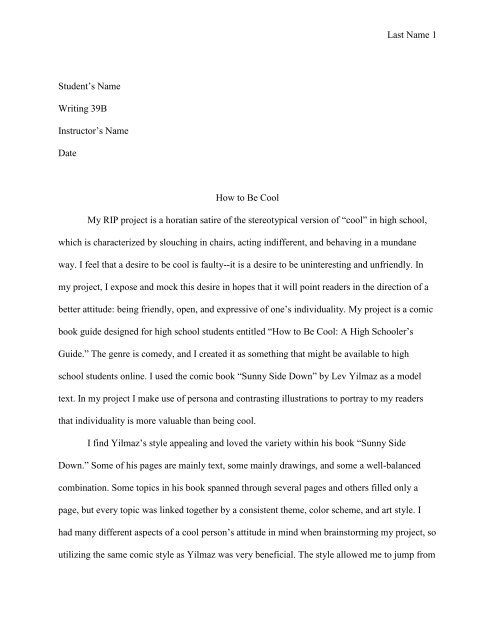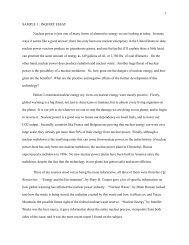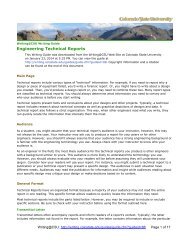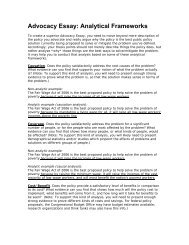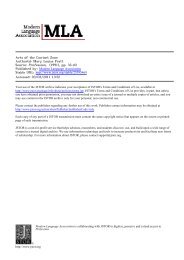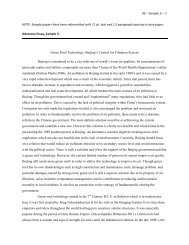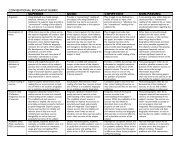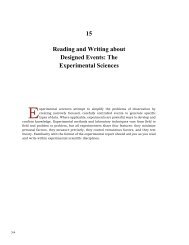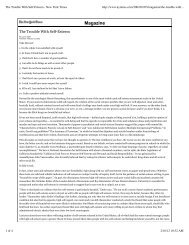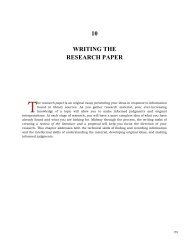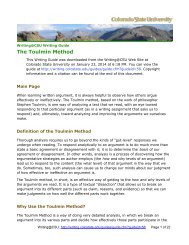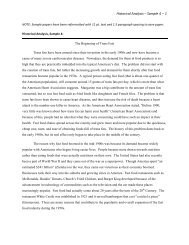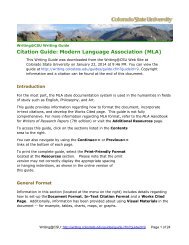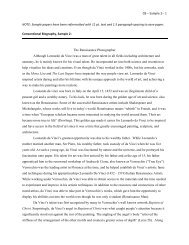Last Name 1 Student's Name Writing 39B Instructor's Name Date ...
Last Name 1 Student's Name Writing 39B Instructor's Name Date ...
Last Name 1 Student's Name Writing 39B Instructor's Name Date ...
Create successful ePaper yourself
Turn your PDF publications into a flip-book with our unique Google optimized e-Paper software.
<strong>Last</strong> <strong>Name</strong> 1<br />
Student’s <strong>Name</strong><br />
<strong>Writing</strong> <strong>39B</strong><br />
Instructor’s <strong>Name</strong><br />
<strong>Date</strong><br />
How to Be Cool<br />
My RIP project is a horatian satire of the stereotypical version of “cool” in high school,<br />
which is characterized by slouching in chairs, acting indifferent, and behaving in a mundane<br />
way. I feel that a desire to be cool is faulty--it is a desire to be uninteresting and unfriendly. In<br />
my project, I expose and mock this desire in hopes that it will point readers in the direction of a<br />
better attitude: being friendly, open, and expressive of one’s individuality. My project is a comic<br />
book guide designed for high school students entitled “How to Be Cool: A High Schooler’s<br />
Guide.” The genre is comedy, and I created it as something that might be available to high<br />
school students online. I used the comic book “Sunny Side Down” by Lev Yilmaz as a model<br />
text. In my project I make use of persona and contrasting illustrations to portray to my readers<br />
that individuality is more valuable than being cool.<br />
I find Yilmaz’s style appealing and loved the variety within his book “Sunny Side<br />
Down.” Some of his pages are mainly text, some mainly drawings, and some a well-balanced<br />
combination. Some topics in his book spanned through several pages and others filled only a<br />
page, but every topic was linked together by a consistent theme, color scheme, and art style. I<br />
had many different aspects of a cool person’s attitude in mind when brainstorming my project, so<br />
utilizing the same comic style as Yilmaz was very beneficial. The style allowed me to jump from
<strong>Last</strong> <strong>Name</strong> 2<br />
topic to topic, such as from attitude to hairstyle, with ease. It also gave me freedom to comment<br />
on each topic in the way I saw fit; I was not constrained to a consistent layout or ratio of text to<br />
art.<br />
In order to appeal to high school students and help get my message across, I used a<br />
catchy color scheme, sloppy fonts, and simple art. I selected a bright and eye-catching color<br />
scheme that I felt would contrast nicely with the images of cool people within the book—making<br />
them look dull by contrast. I also felt the colors were overly cheery and added to the guide’s<br />
enthusiasm, which teenagers could relate to the overly-optimistic inspirational posters popular at<br />
elementary and high schools. Though my guide may be similar to these posters by sharing the<br />
theme of “be yourself,” high school posters preach this topic by stressing the benefits of<br />
expressing yourself. However, I aim to persuade the reader to be an individual by poking fun at<br />
those who aren’t. I do this by sarcastically advising the reader on how to be a stereotypical cool<br />
person. This contrast between the cheerful optimism of an inspirational poster and directions on<br />
how to be stereotypical, mundane, and smug adds to the guide’s comedy and appeals to<br />
teenagers because it also mocks the inspirational advice they’ve grown up with and likely roll<br />
their eyes at. For much of the text in my guide I chose a hand drawn look. The title is in hand<br />
drawn lettering, much like the movies “Juno,” “Scott Pilgrim vs. the World,” and “Nick and<br />
Norah’s Infinite Playlist” which are aimed towards teen audiences and had similar lettering. The<br />
text within the guide is a hand drawn style as well. I felt that a standard font would be associated<br />
with textbooks and academic writing, so to avoid this relation I chose a casual, sloppier font.<br />
This will appeal to my audience because it sends the message that this guide is meant for casual<br />
entertainment, which most teenagers will prefer to a text that appears educational or that appears<br />
to take a high degree of focus to read and understand. My art is also simple, with limited shading
<strong>Last</strong> <strong>Name</strong> 3<br />
and details. High school students can associate this with internet comics or other simple, easy to<br />
understand formats.<br />
In “How to Be Cool” I utilize dual personas to expose faults within a cool person’s<br />
attitude. Throughout the guide, my persona has a very instructive and knowledgeable tone and<br />
gives advice on how to be cool, yet at times I have inserted my own comments, which are much<br />
more direct attacks on the attitude of a cool person than the persona’s instructions. This is similar<br />
to Jonathan Swift’s technique within “A Modest Proposal.” Though most of the proposal was<br />
written in the voice of Swift’s persona, there are times at which Swift intrudes to make more<br />
cutting attacks. My persona advocates being cool, yet my own comments expose the attitude’s<br />
hypocrisy or faults. On the page entitled “People You Dislike,” for example, my persona is<br />
providing information about what groups of people to dislike and why. Yet after the listing of<br />
“the openly gay” I have inserted my own comment, “They are much too comfortable with<br />
themselves, a luxury you can’t enjoy.” This comment is a direct stab at the cool attitude,<br />
suggesting that cool people dislike groups which express themselves freely because cool people<br />
are jealous that they don’t have a similar level of comfort. In another example, on the page<br />
“Expert Advice,” my persona provides a quote from an imaginary character, Joe, who complains<br />
about the inconvenience of heavy textbooks. He then complains that rolling backpacks are<br />
“dorky” and advices, “If you’re cool, you will demonstrate your disapproval* of this<br />
‘convenience’ [rolling backpacks].” Joe feels that heavy textbooks required for class are<br />
inconvenient, but later in an illustration kicks a rolling backpack because it is dorky. However,<br />
rolling backpacks are a realistic solution to the very thing he is complaining about—the<br />
inconvenience of heavy textbooks. So, within Joe’s quote I added an asterisk after “disapproval”<br />
which led to my own commentary: “possible jealousy of convenience.” My comment makes a
<strong>Last</strong> <strong>Name</strong> 4<br />
point of Joe’s hypocrisy and suggests that the true motive for disapproval of rolling backpacks is<br />
that a cool person wouldn’t be confident enough to make use of one him or herself. A high<br />
school student can relate to these examples because homosexuality is currently a popular<br />
controversy in high schools and rolling backpacks are something generally understood as<br />
“uncool.”<br />
I also use contrasting illustrations to magnify the effect of a cool attitude on a person.<br />
Throughout the guide, the cool people are drawn in dull colors that do not stand out. This<br />
contrasts with the images of the non-cool students, who vary greatly in colors of clothing. This is<br />
to emphasize that an attitude which advocates being disinterested in turn makes the person<br />
uninteresting. Furthermore, in the majority of the illustrations, the cool person is expressing<br />
boredom, smugness, or unhappiness, while other people are joyful and expressive. The cool<br />
people are unexpressive because they are instructed by their stereotype to be this way, yet I<br />
chose to make others very expressive to make it look like being an individual, friendly, and<br />
interested was more fun and exciting than being cool. An example of this contrast can be seen on<br />
the first and last pages of the guide. When the guide begins, an excited character in bright clothes<br />
has his arms thrown up in anticipation of learning to be cool. Yet, on the last couple pages, the<br />
character is shown again with a calmer hairstyle, an unhappy expression, crossed arms, and dull<br />
clothes. With this contrast I displayed how much less appealing the character was once he<br />
became cool, and on the final page he tellingly wonders, “Is it cool to miss the uncool me”<br />
I am not only very relieved to be done with my project, but I am very glad I did it. For<br />
several years I have been interested in learning how to design images on Photoshop, but I never<br />
had the motivation to do it. I knew I wanted my project to be paper comic book, and I quickly<br />
realized that if I wanted it to look professional, I had to ditch the colored pencils and design my
<strong>Last</strong> <strong>Name</strong> 5<br />
pages digitally. My goal for this project forced me to put up with the frustration and difficulties<br />
of figuring out Photoshop, and now I have basic knowledge that I can build on in the future. I<br />
was also concerned that I wouldn’t have time to finish this project, but somehow it all fell<br />
together just in time. Although it’s not perfect, I am fairly proud of my final product and hope<br />
that it marks the beginning of more digital artistic creations in my future.


